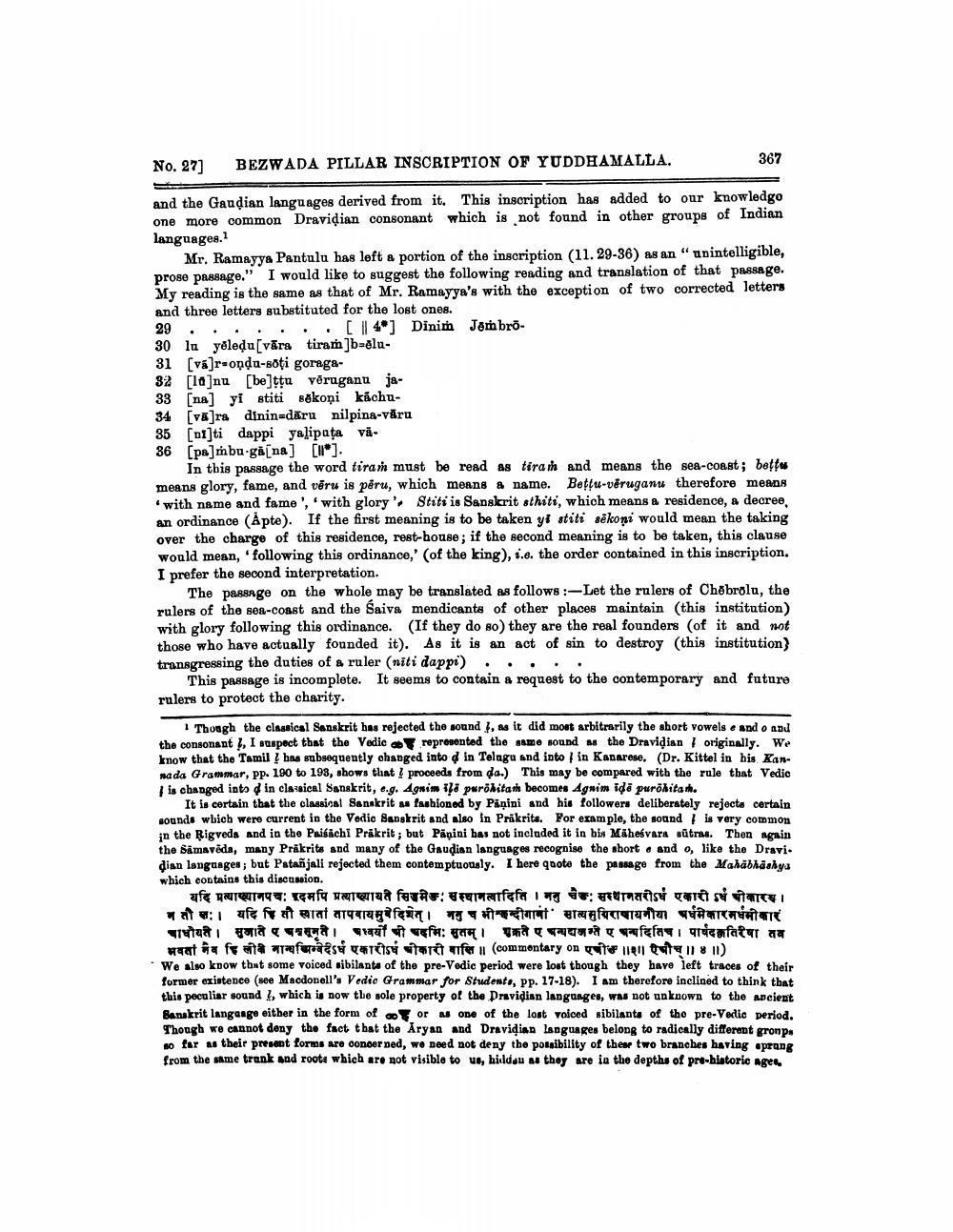________________
No. 27]
BEZWADA PILLAR INSCRIPTION OF YUDDHAMALLA.
367
and the Gaudian languages derived from it. This inscription has added to our knowledgo one more common Dravidian consonant which is not found in other groups of Indian languages.
Mr. Ramayya Pantulu has left a portion of the inscription (11. 29-36) as an "upintelligible, prose passage." I would like to suggest the following reading and translation of that passage. My reading is the same as that of Mr. Ramayya's with the exception of two corrected letters and three letters substituted for the lost ones. 29 . .. .
[ | 4*] Dinim Jambro30 lu yèledu(vāra tiram]b-elu31 [válreondu-soți goraga32 [lajnu [be]ttu võraganu ja33 [na] yi stiti sekoņi kachu34 [vara dinin=dāru nilpina-vāru 35 [n]ti dappi yalipata vå. 36 [pa]nbu-gä[na] [1*].
In this passage the word tiram must be read as tirah and means the sea-coast; bettu means glory, fame, and vēru is pēru, which means a name. Betfu-vöruganu therefore means
with name and fame', with glory Stiti is Sanskrit sthiti, which means a residence, a decree. an ordinance (Apte). If the first meaning is to be taken yi stiti sēkoni would mean the taking over the charge of this residence, rest-house; if the second meaning is to be taken, this clause would mean, 'following this ordinance,' (of the king), 1.6. the order contained in this inscription. I prefer the second interpretation.
The passage on the whole may be translated as follows:-Let the rulers of Chobrolu, the rulers of the sea-coast and the Saiva mendicants of other places maintain (this institution) with glory following this ordinance. (If they do so) they are the real founders (of it and not those who have actually founded it). As it is an act of sin to destroy (this institution transgressing the duties of a ruler (niti dappi) . . . . .
This passage is incomplete. It seems to contain a request to the contemporary and future rulers to protect the charity.
Thuagh the classical Sanskrit has rejected the sound, as it did most arbitrarily the short vowels e and o and the consonant, I suspect that the Vedie de represented the same sound as the Dravidian originally. We know that the Tamil has subsequently changed into din Telugu and into in Kanarose. (Dr. Kittel in his Kannada Grammar, pp. 190 to 198, shows that I proceeds from da.) This may be compared with the rule that Vedio is changed into in classical Sanskrit, e.g. Agnim ili purohitan becomes Agnim idä puröbitat.
It is certain that the classical Sanskrit as fashioned by Panini and his followers deliberately rejects certain sounds which were current in the Vedio Sanskrit and also in Prakrits. For example, the sound is very common in the Rigveda and in the Paisachi Prakrit; but Pāṇini has not included it in his Māheśvara sūtras. Then again the Samavēda, many Prakrits and many of the Gaudian languages recognise the short . and o, like the Dravi. dian languages; but Patañjali rejected them contemptuously. I here quote the passage from the Mahabhishya which contains this discussion.
यदि प्रत्याख्यानपच: बदमपि प्रत्याख्यायते सिजमेर: सस्थानत्वादिति । मनु : सस्थानतरीऽध एकारी धोकारव। मतौसः। यदि किसी स्थानां तापवायमुदिशेत्। मनु च मीछन्दीगामी सात्यमपिराणायनीया वर्धमेकारमधमोकारं
चाधीयते। सुजाते एचसूनुते। सवयों ची पदमिः सुतम्। शकते ए पन्धद्यमन्ते ए पन्धदितिच। पार्षदकतिरषा तब wat ha fe aita araferaese #t v starit ferul commentary on it all to 8 11) We also know that some voiced sibilants of the pre-Vedic period were lost though they have left traces of their former existence (see Macdonell's Vedic Grammar for Students, pp. 17-18). I am therefore inclined to think that this peculiar sound l, which is now the sole property of the Dravidian languages, was not unknown to the ancient Sanskrit langeage either in the form of or as one of the lost voiced sibilants of the pre-Vedic period. Though we cannot deny the fact that the Aryan and Dravidian Languages belong to radically different gronpa 80 far as their present forms are concerned, we need not deny the possibility of these two branches having sprang from the same trank and roote which are not visible to us, hideu as they are in the depths of pro-blatorie Age




